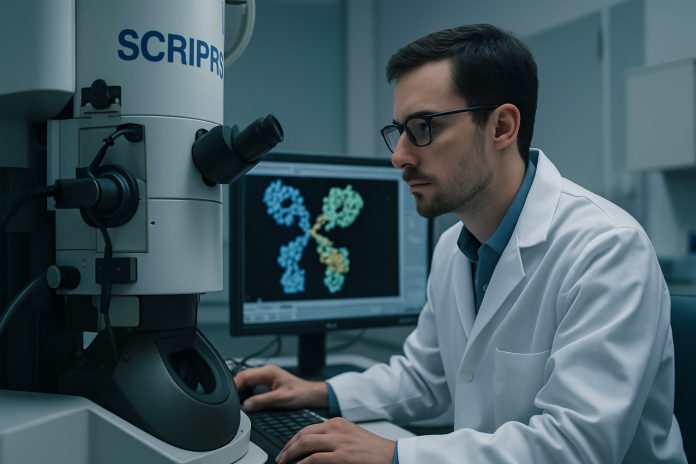Quick Take
- Weeks to hours: Scripps AI-cryoEM slashes antibody discovery timelines; Impact: Faster outbreak countermeasures
- Pipeline focus: Structure-to-Sequence (STS) links cryoEM with ModelAngelo; Impact: Pinpoints protective antibodies faster
- Preparedness boost: Under-a-day reads enable rapid therapeutics; Impact: Shortens response in health emergencies
- Cross-disease potential: Targets influenza and HIV candidates; Impact: Broader infectious-disease applications
A breakthrough artificial intelligence system from Scripps Research transforms antibody discovery from weeks-long processes to hours-long operations, potentially revolutionizing pandemic response capabilities. — Science Advances
Scientists have dramatically accelerated antibody discovery, cutting the process from weeks down to just hours using artificial intelligence and cryo-electron microscopy. The findings, published in Science Advances, represent what researchers call a major leap forward for pandemic preparedness.
Andrew Ward, professor at Scripps Research, describes the advancement: “This represents a paradigm shift in how we discover antibodies.” The team’s work addresses one of the biggest bottlenecks in developing new treatments – the time it takes to identify promising therapeutic candidates.
Ward added, “This method could be game-changing for pandemic preparedness and therapeutic development.” The accelerated pipeline is positioned to speed drug programs at the earliest, most time-critical stages.
Revolutionary Structure-to-Sequence Method Emerges
The breakthrough centers on what Scripps researchers call Structure-to-Sequence (STS). This innovative approach combines high-resolution cryoEM imaging with ModelAngelo, an AI tool that can rapidly analyze complex biological structures.
The process works by examining how immune systems respond to threats, then matching those structural patterns to antibody sequences stored in genetic databases. Instead of the traditional trial-and-error screening methods, scientists can now pinpoint the most promising candidates in under a day.
By removing guesswork in early screens, STS identifies promising candidates in under a day. Research from Scripps Research plans to expand collaborations shows proof-of-concept in animal models, with flu-focused work demonstrating practical momentum and laying groundwork for broader use.
Pandemic Applications Target Multiple Diseases
The timing couldn’t be more critical. When disease outbreaks occur, every hour counts in developing effective treatments. The STS approach offers a direct window into how antibodies attach to their targets, allowing researchers to quickly identify the most effective therapeutic leads.
This capability shows particular promise for challenging diseases like influenza and HIV, where rapid viral evolution has historically complicated treatment development. The ability to quickly analyze structural interactions could help scientists stay ahead of these fast-changing pathogens.
Scripps Research positions the pipeline as a preparedness tool: faster triage of antibody candidates, clearer prioritization, and earlier movement into preclinical testing. The result is a shorter path from discovery to formulation when timing is critical.
| Discovery Method | Timeline | Key Technology |
|---|---|---|
| Traditional discovery | Weeks to identify candidates | Manual screening |
| STS (AI + cryoEM) | Hours, often under a day | AI-guided structure analysis |
Implementation Challenges Remain Significant
Despite the promising results, the research team acknowledges significant hurdles ahead. Scaling this technology to widespread use will require extensive partnerships between research institutions and integration with existing healthcare infrastructure.
The approach must also align with downstream manufacturing and regulatory steps, which are not detailed. Questions remain about how consistently the method will perform across different laboratories and research settings.
Still, the structural readouts paired with AI guidance suggest a repeatable framework. If adoption spreads, institutions could coordinate rapid candidate identification and move promising antibodies into development faster than current norms.
Research Expansion Plans Take Shape
Looking ahead, Scripps Research has outlined plans to broaden their collaborative network and extend the method’s disease coverage. Early evidence from animal models supports the approach’s feasibility, while internal partnerships focus on refining formulations that could eventually become approved therapies.
The research team frames STS as more than a single-use tool – they see it as a foundational improvement to how the scientific community approaches antibody discovery. As the method matures, it could standardize early discovery processes across different pathogens and strengthen global preparedness for future health emergencies.






